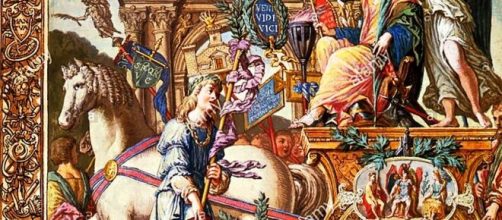This story points to reasons why art historians should get the big bucks.
Studying the past can clue us into puzzling exhibits like Andrea Mantegna’s 9-painting series “Triumph of Caesar” newly exhibited at the National Gallery in London.
Remembrance of things past
The style of the figure-paintings in this show calls out for someone to explain why they bear so little resemblance to the sculptural figure-paintings for which Mantegna is known.
A good example of his flinty figures is his painting of the Biblical story Judith and Holofernes, which he pictured without color to make the image resemble stone.
Historian Giorgio Vasari’s study of Mantegna explained the stone-like look of his figures, saying it reflected the artist’s love of ancient statuary, and all things Roman. The artist even designed his home like a Roman villa.
But what accounts for this other look showing in “Triumph of Caesar?” Instead of the figures looking carved, they look outlined. They look like line drawings not unlike the graphic illustrations in classic comic books.
Granted, I’m looking at these images from press releases, not in situ. But a couple of historians also observed this outlining. Peter and Linda Murray logged their findings in their 1985 book “Art of the Renaissance.”
“He had a passion for archaeological exactitude,” the Murray’s wrote.
You could see this in his triumphal arches and the armor, down to the last detail. The focus was on detail, not 3-D.
“His handling of detail is painfully precise,” the Murray’s added, citing the lines and creases of facial expressions and in the clinging folds of his draperies.
These historians weren’t referring to “The Triumph of Caesar” when they recorded these factoids. But you can easily see their point in this series.
The Murrays attributed Mantegna’s “passion for archaeological exactitude,” and his inclination to describe with “hard metallic, wiry outlining” to his experience in his teen years.
That’s when Mantegna became interested in archaeology, a result of a friendship with Francesco Squarcione, who was an archaeologist as well as a painter.
The teenager learned the tricks of the trade and got good at accurately recording detail from the diggings.
Style change
Squarcione, by the way, worried about his influence on his young friend’s work, telling him it was inferior because it was copied from marble statues.
Mantegna began to paint from live models. And, according to Vasari, he made so much progress that his life drawing became as effective as his derivations from sculpture.
Can that be why Mantegna’s once sculptural painting turned into the look of drawings?
Of course, you don’t need any of this history to enjoy the National Gallery’s new show. The Guardian art critic Jonathan Jones demonstrates this when on seeing “Triumph of Caesar” he exclaimed, “You can hear the trumpets and smell the elephant dung.”
Jones went on sounding nearly bewitched by what he described as Mantegna’s “smoky colors and brooding faces, empty armor and paraded elephants fill the twilit cavalcade.”
I want to end this story with another bow to historians.
A New Yorker cartoon mocked them some years ago with a cartoon showing a bespeckled old man pouring over several open books in a room lined with them.
And standing in the doorway was an elderly woman, presumably his wife, calling to him, “Happy New Year, dear!” The joke was on the scholar for burying himself in the past and ignoring the present.
But somebody has to do it. Otherwise, we’ll all end up living in current events. And we all know what a horror show that can be.


